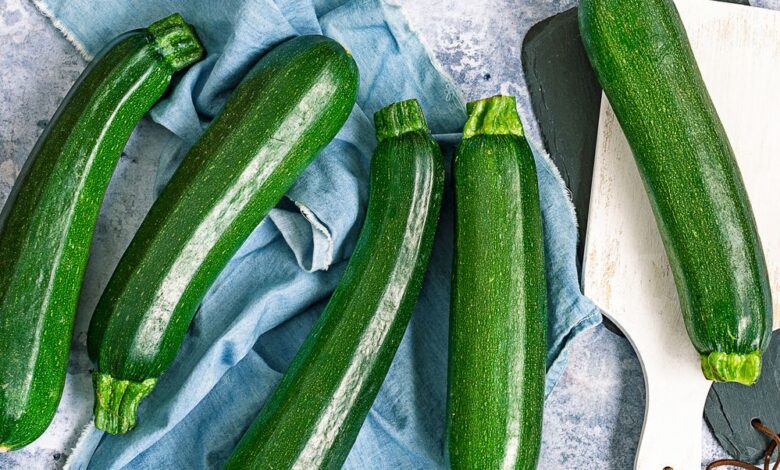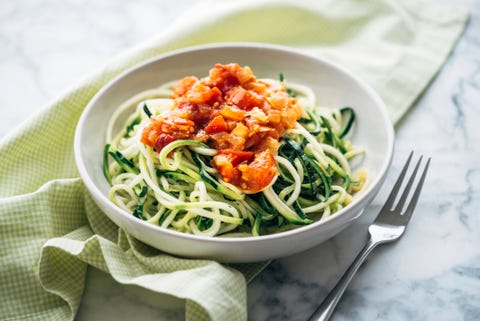6 Zucchini Health and Nutritional Benefits

If zucchini can become spaghetti, you can do anything. Seriously, this simple vegetable not only has some serious nutrition superpowers, but it also allows for a ton of culinary creativity in the kitchen. Part of the summer squash family, zucchini has a mild flavor and pairs well in a ton of versatile dishes. Here’s everything you need to know about the veggie, including nutrition stats and delicious recipes.
This content is imported from {embed-name}. You may be able to find the same content in another format, or you may be able to find more information, at their web site.
Zucchini Nutrition Data
Serving Size: 1 medium zucchini
- 33 calories
- 1g total fat
- 0g saturated fat
- 0g trans fat
- 0mg cholesterol
- 16mg sodium
- 6g total carbohydrates
- 2g dietary fiber
- 5g sugars (includes 0g added sugars)
- 2g protein
- Calcium: 2% Daily Value
- Iron: 4% Daily Value
- Magnesium: 8% Daily Value
- Potassium: 11% Daily Value
- Vitamin C: 58% Daily Value
- Vitamin B6: 15% Daily Value
Health Benefits of Zucchini
In season from June through October, summer squashes like zucchini are low in calories but rich in nutrients. Here are just a few of the potential health benefits of this incredible veggie:
- Can help fight inflammation: Zucchini is rich in several different types of antioxidants which can help fight free radicals and ward off inflammation. Enjoy zucchini with the skin on for full nutrition benefits, as much of the nutrients are in the skin itself.
- Can support a healthy immune system: Just one medium zucchini provides over half your day’s worth of vitamin C, an important antioxidant and water-soluble vitamin that plays a major role in immune function. Vitamin C also plays a role in reducing risk of several chronic diseases.
- May support blood sugar control: Naturally low in carbohydrates, zucchini can be a great lower-carb alternative to more starchy vegetables and refined carbohydrates at any meal. Zucchini noodles make a great swap for spaghetti and lasagna in many recipes, helping to keep blood sugar levels at bay and limit blood sugar spikes from excessive refined carbohydrates. You can even try half regular linguine and half zucchini noodles which can still significantly reduce the carbohydrate load of the meal but give you the best of both worlds. Zucchini can even be made into chips or fries in the air fryer, providing a delicious and satisfying low-carb alternative.
- Can promote good digestion: Both the fiber and water content in zucchini can help keep you regular and support healthy digestion. Zucchini is also considered a low-FODMAP vegetable, which means it may be easier to digest especially for individuals with irritable bowel syndrome.
- May assist with weight management: Zucchini is naturally low in calories but abundant in nutrients, making it a great addition to a healthy diet. Plus, zucchini naturally has a high water content and also contains fiber, both of which can help keep you full. Swapping noodles for zucchini noodles can significantly cut down on calories and carbohydrates in a meal but still provide volume and satiety.
- May support a healthy heart. One medium zucchini is a good source of potassium, a mineral and electrolyte that helps with nerve and muscle function. Potassium plays a big role in helping your heartbeat stay regular, and a potassium-rich diet can help offset some of the harmful effects of sodium on blood pressure. Zucchini also contains magnesium, another important mineral that helps keep heart rhythm steady.
Zucchini shopping and storage tips:
When shopping for best quality zucchini, look for young and tender varieties that are about 6 to 8 inches long and 2 inches in diameter. Ideally, the skin should be shiny and glossy with the veggie itself feeling firm. Make sure the varieties you pick are free of wrinkled skin and soft spots. You may be tempted to buy larger varieties, but as a zucchini grows bigger it can become tougher and also develop more seeds; those larger zucchini varieties tend to be best for grating in things like zucchini bread, just be sure to scoop out the seeds first.
Use your zucchini ideally within a few days of purchase, and wait to wash it until just before preparation for maximum freshness. Store unwashed zucchini in a perforated plastic bag in the crisper drawer of the fridge.
How to cook with zucchini:
This versatile vegetable can be used raw or cooked, even grated or spiralized into different recipes. Most of the vitamins and minerals are found in the zucchini skin so be sure to keep the skin on whether you are cooking the vegetable or eating it raw. Try zucchini steamed, grilled, sautéed or raw in salads. You can even use zucchini in baked goods, dips and more. Pureeing zucchini adds bulk and a thick texture without using cream too. Given its mild flavor, zucchini pairs well with different herbs and seasonings. These 50+ zucchini recipes are sure to give you some inspiration in the kitchen.
This content is created and maintained by a third party, and imported onto this page to help users provide their email addresses. You may be able to find more information about this and similar content at piano.io
Source link




